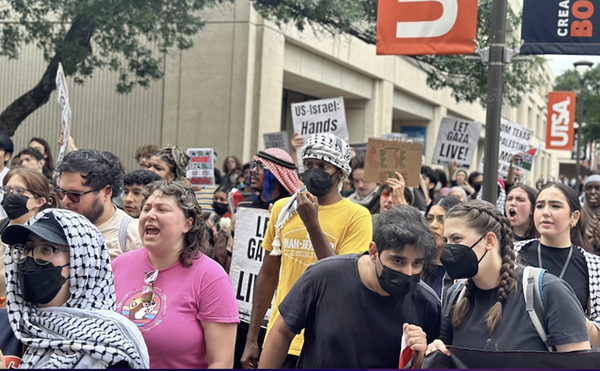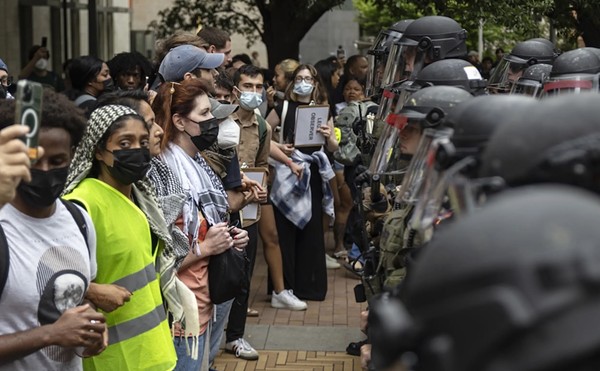One night in 2003, police responded to a disturbing-the-peace call at a Southside McDonald’s. Inside, they encountered a man crouched in the corner of the restaurant, screaming the Lord’s Prayer. Before being hauled off to jail, the man told officers the prayer helped calm the voices screaming inside his head.
To Leon Evans, who runs the Center for Health Care Services, the story is just one of countless he heard when he and other mental health experts first began training local police officers how to respond to cases of obvious mental illness. At the time, such run-ins with the law almost always meant prison time for the mentally ill — something Evans and others at the Center have tried to change in San Antonio over the past eight years.
“We realized officers didn’t really have a choice then. They couldn’t leave the man there because he could have hurt himself or someone else. `The officer` took him to jail, which he felt bad about, because, really, the man wasn’t a criminal. … Is it right to criminalize someone who has a mental illness?” Evans asked in a recent interview with the Current. “Unfortunately, that’s historically what happened, because we just didn’t have the resources.”
Texas ranks 49th in spending on mental health, according to the Texas Medical Association. Yet despite the state’s long history of underfunding mental health care, Evans and others are frustrated to see lawmakers pushing the bar even lower. Current state budget proposals would make deep cuts to community mental health programs — programs that have proven effective at keeping the mentally ill, homeless, and drug-addicted out of jail and in treatment.
The Center, Bexar County’s government-funded community mental health center, gives outpatient treatment — either medication, counseling, or some combination of the two — to about 6,000 patients each month — 2,000 more than what the state funds are supposed to pay for each month, according to Evans.
In 2003, the Center started partnering with the city and county to look for ways to keep the mentally ill out of jails and in treatment, building a Crisis Stabilization Unit, a 24-hour in-patient clinic for those going through psychiatric crisis, and a substance abuse center with detox and intensive substance abuse units.
Officials at the Center estimate that roughly 60 percent of those routinely picked up by police for being drunk in public have a major mental illness — including suicidal thinking, active schizophrenia, major depression, and bipolar disorders. About 60 to 70 percent of the homeless population suffers from mental illness, they say.
Through the jail diversion programs, the Center says it keeps 800 to 1,000 people out of the jail and local emergency rooms every month, Evans said, representing a large savings to local taxpayers. According to the Center, those diversion programs have helped save both the city and county a combined $15.5 million over the past two years.
“We decided that we have limited dollars and if we really want get the best return for the taxpayers of Bexar County we should serve people in psychiatric crisis,” he said.
The idea of diversion and treatment instead of incarceration isn’t a novel one. Numerous studies have shown that treatment alternatives greatly reduce the likelihood that someone with mental illness, addiction, or someone who’s homeless will reoffend and wind up back in jail.
When parolees are treated for mental illness or addiction, there’s about a 10-percent chance they’ll reoffend, Evans said. Without treatment, that chance jumps up to around 60 percent.
Still, alternatives to treatment, no matter how effective, are hard to fund. And soon after Evans took the helm in 2003, the Center took a $6-million hit in funding from the state and had to cut 138 positions as the state tried to dig itself out of another multi-billion-dollar budget shortfall.
This time around, Evans says he has no idea how the Center can take the cuts and sustain its programs. In the draft state budget, community mental health centers could face at least a 20-percent cut in funding, and Evans says he’s expecting the Center could lose $10 to $12 million from the state — about a sixth of the Center’s overall budget. The cuts would require elimination of about 180 positions from the Center’s 730-person staff, he said. “We’re going to get slaughtered. I’m afraid a lot of these programs are at risk.”
David Goodykoontz is on the front lines of the Center’s jail diversion efforts as part of the Center’s PATH team (Projects for Assistance in Transition from Homelessness). Operating out of Haven for Hope, the city’s sprawling homeless-services campus, the team targets the homeless population in shelters, under bridges, and in alleyways, urging the homeless to consider psychiatric and substance abuse treatment.
Last week, Goodykoontz and Maricela Hernandez, another PATH outreach worker, found 40-year-old Anthony Taylor sleeping underneath a pile of tattered, stained blankets near the railroad tracks on the corner of Salado and Monterey. After brief introductions, Taylor told them he suffers from bipolar disorder, and though he once had Section 8 housing, he was evicted from his apartment a few months back.
“I’ve been out here since then,” Taylor muttered softly. Goodykoontz took down Taylor’s information and set up a time to meet with him the following day to fill out paperwork and start the process of getting him properly diagnosed and, hopefully, into treatment.
“Just the situation of being displaced, of being homeless, that can bring you to your knees and cause some of these problems with mental illness,” Goodykoontz said as he drove away. “On the flipside, these severe mental health problems, if not treated, can put you on that path to homelessness,” he said. “It’s like a revolving door.”
Soon afterward, Goodykoontz and Hernandez came across a small group living underneath a downtown highway overpass. One man, “Donald,” spoke wildly, speeding in and out of conversation, at times growing combative. With the strong scent of alcohol on his breath, he pulled out two pill bottles he said were for bipolar disorder. “Mental illness? Yep. Addiction? Yep,” he said, laughing.
Donald’s train of thought was scattered: He was a military veteran who couldn’t find work, he said, before declaring himself a champion marathon runner. “Look for me in the newspapers next week. I’ve got a marathon coming up.”
After Donald became increasingly combative, Goodykoontz and Hernandez retreated, the conversation about treatment options aborted. “Homelessness didn’t happen overnight, and we’re not going to cure it overnight,” Goodykoontz said with a sigh. “But I fear these cuts mean there’s going to be a whole lot more people suffering,” he said. “We’re basically going from bad to worse.”
Goodykoontz said his team is already stretched so thin that he worries additional cuts would leave hundreds falling through the cracks. Currently, five outreach workers juggle about 30 cases each at any given time. Most are homeless individuals, difficult to track down and keep in treatment.
Outside the Haven for Hope campus, Goodykoontz bumped into Judi Cardenas, a woman he found last year at Haven’s homeless shelter and helped direct toward psychiatric treatment. Cardenas, who suffers from bipolar disorder, has also had long stays at San Antonio’s Battered Womens Shelter, saying years of abuse have left her with post-traumatic stress disorder.
“I had a real hard time finding the right treatment,” she said. “I used to just self-medicate.” Calling Goodykoontz “one of the few good men I’ve ever met in my life,” Cardenas said the goal now is to get stable, get a job, and find housing. “If I hadn’t found something that works, I’m afraid I’d be out there drunk on and off the streets,” she said. “I’d probably be dead. No one would have expected me to live.”
Eyeing deep cuts to the state’s social safety net, mental health advocates have advanced the economic argument for maintaining services to the mentally ill, calling cuts to the community mental health centers a short-sighted and costly move for the state.
According to the state’s Legislative Budget Board, community mental health services cost about $12 per day per patient, as opposed to the $137 per day it costs to keep someone in prison. Evans estimated the average homeless person costs taxpayers about $30,000 per year in emergency room fees and jail costs. “We spend a whole lot of money corralling these people, incarcerating these people,” Evans said. “It’s not just our moral obligation. When you really look at the costs, `treatment` is very cost-effective.”
The solution to the state’s woes, according to Janet Paleo, a San Antonio mental health advocate, is healing these shattered lives and returning them to productive lives.
“You want to end the `budget` shortfall? Get these people back to work, and make them taxpaying citizens.” Paleo, a founder of Prosumers International, suggested months ago that the state could be setting itself up for a lawsuit. “We want the state to know `mental health cuts` could be a possible civil rights violation,” Paleo said, referencing a case in North Carolina where disability rights advocates sued the state after it tinkered with mental health funding.
And while less funding from the state would restrict assistance, a recent report presented before the Bexar County Commissioners Court shows just how much the demand for mental health care already outweighs services available.
The report, by U.S. Army Medical Service Corps analyst Maj. Samantha Hinchman, shows that rising numbers of indigent mentally ill patients are flooding private and public hospitals in the county. From July to December 2009, over 37.5 percent of ER patients with mental illness sought charity care. Twenty-five percent of those patients were identified for “emergency detention,” meaning they were ordered to undergo further psychiatric evaluation at a mental health facility. The study estimated indigent mental health care in ERs was costing hospitals as much as $4.3 million per year. For inpatient care, 28 percent of the mentally ill patients sought charity care, costing hospitals an additional $14 million every year, according to the report.
“If a solution to this problem is not found then the hospitals may need to consider less than optimum solutions to stop their financial losses,” the report concludes.
Probate Court Judge Polly Jackson Spencer, who called for the report last year, said, “What could happen is a private hospital could start saying, ‘We don’t provide psychiatric care any longer, don’t bring your `mentally ill` people to our emergency rooms,’” restricting access to mental health care and funneling patients to the Center, the state hospital, or the jail.
Bexar County, she said, is already “in the basement” in terms of funding for community mental health care. “`State cuts` are just going to exacerbate an already bad problem here,” she said.
“I think there must not be that many people in the Legislature who have mentally ill family members.”
And it’s not only mental health advocates who are decrying cuts to community mental health programs. In written testimony before the State Senate Finance Committee last month, state jail officials told lawmakers that severe cuts to mental health programs could flood Texas jails.
Bexar County Jail Administrator Roger Dovalina told the Current last week, “The cuts would put us in a really tough position. … It becomes a safety and a security issue once you have to house more people, especially those with mental illness. We might have a situation where someone’s deteriorating in here, and to be honest, we’re a jail facility, not a state hospital.”
According to jail officials, about 900 of Bexar County Jail’s 4,000 inmates are on psychotropic medication. The jail currently has 281 designated mental health beds, and jail staff say those beds are routinely filled.
Martha Rodriguez, the jail’s medical director, said that 15 percent of men and 30 percent of women in the jail have a mental illness. “County jails are the pipeline to state prisons, so ultimately, the state will have to pay for mental health services when the inmates get to prison,” she said. “So, the more recidivism at the local level, the more the state will have to pay downstream. It is definitely a ‘pay now, or pay even more later’ scenario.”
Compounding the problem, jails themselves aren’t immune from the budget axe. Lawmakers have also proposed defunding prison health expenses by 23 percent, including serious reductions in psychiatric services and prescription medications for inmates. The state is also considering all but eliminating a Treatment Alternatives to Incarceration program with the Texas Department of Criminal Justice, cutting 90 percent of the program’s funding.
Kathryn Jones, director for the Center’s substance abuse treatment services, said the cuts ultimately target the same population — the homeless, mentally ill, and drug-addicted. “These people don’t go away. … They will just back up in your jails and in your emergency rooms and on your streets,” Jones said. “There’s no way we can continue what we’ve been doing with a 20-percent cut.”
Sitting at the conference table in his office, Evans shook his head. “Even though we’re diverting all these people right now, the biggest mental health facility in our county is still the jail, and that’s the truth in almost every community. What does that say about our society?”
6,000: Number of people assisted by The Center for Health Care Services every month — about 2,000 more than the state actually pays for.
800-1,000: Number of people with mental illness diverted every month from Bexar County Jail by CHCS.
$15.5 million: Amount CHCS says it has saved San Antonio and Bexar County between 2008 – 2010 through jail diversion programs.
20 percent: Amount state budget proposals would cut CHCS’ funding (from $62 million to about $50 million)
23 percent: Proposed state cuts to prison medical care, including deep cuts to psychiatric services and prescription meds.
900: The number of inmates in the Bexar County Jail taking psychotropic meds, out of a population of about 4,000.
90 percent: Virtual elimination of the Texas Department of Criminal Justice’s Treatment Alternatives to Incarceration Program.


















